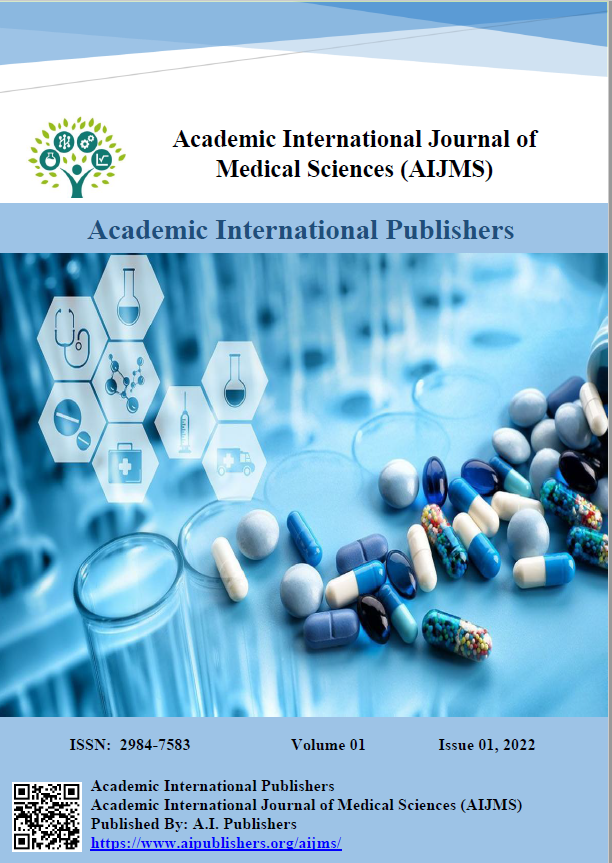Isolation and PCR-Based Detection of Antibiotic-Resistant Bacteria from Hospital Environments
DOI:
https://doi.org/10.59675/M322Keywords:
Environmental surveillance, antibiotic resistance, PCR detection, hospital-acquired infections, MRSA, VRE, ESBLAbstract
The proposed study aimed to assess the occurrence and pattern of antibiotic-resistant bacterium in hospital settings both through traditional methods of culture as well as PCR-based molecular identification. Sampling of the environment of different units in Ramadi Teaching Hospital was carried out over a six-month period. A total of 600 environmental samples were sampled in the high-risk environments such as intensive care units, emergency departments, surgical suites, and medical wards by standardized swabbing methods. Traditional culture methods and PCR amplification based on common resistance genes such as mecA, vanA/vanB, blaTEM, blaSHV, blaCTX-M and qnr genes were used in processing the samples. Findings indicated that the hospital was generally contaminated with antibiotic-resistant bacteria in all hospital units. Out of the 600 samples taken, 387 (64.5% of the total samples) were positive by conventional culture test, and PCR-based results revealed the presence of resistant bacteria in 456 samples (76.0% of the total samples). The highest contamination rates were found in intensive care units with 94.7% of samples being positive on PCR. The most commonly isolated organisms were MRSA (34.2%), VRE (28.7%), and ESBL producing Enterobacteriaceae (41.5%). Detection using PCR was more sensitive (89.2% than the traditional culture methods (64.5%). The environmental contamination rates and the clinical infection rates were strongly correlated (r = 0.742, p < 0.001). The research confirms the usefulness of molecular detection systems in monitoring the environment in hospitals and points to the prevalence of the presence of multidrug-resistant organisms in healthcare settings.
References
Weber DJ, Rutala WA, Miller MB, Huslage K, Sickbert-Bennett E. Role of hospital surfaces in the transmission of emerging health care-associated pathogens: norovirus, Clostridium difficile, and Acinetobacter species. Am J Infect Control. 2010;38(5 Suppl 1): S25-33.
Otter JA, Yezli S, Salkeld JA, French GL. Evidence that contaminated surfaces contribute to the transmission of hospital pathogens and an overview of strategies to address contaminated surfaces in hospital settings. Am J Infect Control. 2013;41(6 Suppl):S6-11.
Dancer SJ. Importance of the environment in meticillin-resistant Staphylococcus aureus acquisition: the case for hospital cleaning. Lancet Infect Dis. 2008;8(2):101-13.
Hayden MK, Blom DW, Lyle EA, Moore CG, Weinstein RA. Risk of hand or glove contamination after contact with patients colonized with vancomycin-resistant enterococcus or the colonized patients' environment. Infect Control Hosp Epidemiol. 2008;29(2):149-54.
Boyce JM, Potter-Bynoe G, Chenevert C, King T. Environmental contamination due to methicillin-resistant Staphylococcus aureus: possible infection control implications. Infect Control Hosp Epidemiol. 1997;18(9):622-7.
French GL, Otter JA, Shannon KP, Adams NM, Watling D, Parks MJ. Tackling contamination of the hospital environment by methicillin-resistant Staphylococcus aureus (MRSA): a comparison between conventional terminal cleaning and hydrogen peroxide vapour decontamination. J Hosp Infect. 2004;57(1):31-7.
Lemmen SW, Häfner H, Zolldann D, Stanzel S, Lütticken R. Distribution of multi-resistant Gram-negative bacteria in the hospital environment: underlying risk factors and infection control implications. J Hosp Infect. 2004;56(3):191-7.
Donskey CJ. The role of the intestinal tract as a reservoir and source for transmission of nosocomial pathogens. Clin Infect Dis. 2004;39(2):219-26.
Tenover FC, Arbeit RD, Goering RV. How to select and interpret molecular strain typing methods for epidemiological studies of bacterial infections. Infect Control Hosp Epidemiol. 1997;18(6):426-39.
Mulvey MR, Chui L, Ismail J, et al. Development of a Canadian standardized protocol for subtyping methicillin-resistant Staphylococcus aureus using pulsed-field gel electrophoresis. J Clin Microbiol. 2001;39(10):3481-5.
Mitchell BG, Dancer SJ, Anderson M, Dehn E. Risk of organism acquisition from prior room occupants: a systematic review and meta-analysis. J Hosp Infect. 2015;91(3):211-7.
Kramer A, Schwebke I, Kampf G. How long do nosocomial pathogens persist on inanimate surfaces? A systematic review. BMC Infect Dis. 2006;6:130.
Huang SS, Datta R, Platt R. Risk of acquiring antibiotic-resistant bacteria from prior room occupants. Arch Intern Med. 2006;166(18):1945-51.
Nseir S, Blazejewski C, Lubret R, Wallet F, Courcol R, Durocher A. Risk of acquiring multidrug-resistant Gram-negative bacilli from prior room occupants in the intensive care unit. Clin Microbiol Infect. 2011;17(8):1201-8.
Shaughnessy MK, Micielli RL, DePestel DD, et al. Evaluation of hospital room assignment and acquisition of Clostridium difficile infection. Infect Control Hosp Epidemiol. 2011;32(3):201-6.
Huslage K, Rutala WA, Sickbert-Bennett E, Weber DJ. A quantitative approach to defining "high-touch" surfaces in hospitals. Infect Control Hosp Epidemiol. 2010;31(8):850-3.
Carling PC, Parry MF, Von Beheren SM. Identifying opportunities to enhance environmental cleaning in 23 acute care hospitals. Infect Control Hosp Epidemiol. 2008;29(1):1-7.
Deshpande A, Cadnum JL, Fertelli D, et al. Are hospital floors an underappreciated reservoir for transmission of health care-associated pathogens? Am J Infect Control. 2017;45(3):336-8.
Bogusz A, Stewart M, Hunter J, Yip B, Reid D, Robertson C, et al. How quickly do hospital surfaces become contaminated after detergent cleaning? Healthc Infect. 2013;18(1):3-9.
Getahun H, Mathai E, Reid A, Shears P, Grzemska M, Van Nguyen T, et al. Tackling antimicrobial resistance in the COVID-19 pandemic. Bull World Health Organ. 2020;98(7):442-442A.
Tacconelli E, Carrara E, Savoldi A, et al. Discovery, research, and development of new antibiotics: the WHO priority list of antibiotic-resistant bacteria and tuberculosis. Lancet Infect Dis. 2018;18(3):318-27.
World Health Organization. Global priority list of antibiotic-resistant bacteria to guide research, discovery, and development of new antibiotics. Geneva: World Health Organization; 2017.
ECDC. Antimicrobial Resistance in the EU/EEA (EARS-Net)—Annual Epidemiological Report for 2019. Epidemiology of antimicrobial resistance EU/EEA. 2020; 174:341.
Centers for Disease Control and Prevention. Antibiotic resistance threats in the United States, 2019. Atlanta, GA: U.S. Department of Health and Human Services, CDC; 2019.
Asmaa G. Nayyef. Bacterial Contamination and Antibiotic Resistance Patterns in Al Anbar Province Water Sources. Aca. Intl. J. P. Sci 2025, 3 (1), 10-17. https://doi.org/10.59675/P312.
Lames H. Almanseekanaa; Raed H. Ogaili. Study on Nourseothricin and Its Activity Against Drug-Resistant Bacteria. Aca. Intl. J. Med. Sci. 2024, 2 (1), 60-68. https://doi.org/10.59675/M216
Downloads
Published
Issue
Section
License
Copyright (c) 2025 Academic International Journal of Medical Sciences

This work is licensed under a Creative Commons Attribution 4.0 International License.





